 The “old” Commons and Commons Mall
The “old” Commons and Commons Mall
- Built: 1973
- Principal Architect: Cesar Pelli (Gruen Associates, Inc. – Los Angeles)
During the 1960’s a lot of American cities, large and small began to recognize that their downtown areas were deteriorating: shopping centers were popping up in outlying areas and large discount stores like Kmart were becoming destinations. Columbus was no exception: downtown was still a destination for many shoppers but it was no longer drawing the crowds it once did. Downtown stores were opening up branches in the new shopping centers or abandoning the downtown altogether. Storefront buildings in the downtown area were deteriorating as stores were beginning to close leaving them unoccupied for long periods leading to further decline. City officials were beginning to take notice.
Recognizing that the downtown was the heart and soul of the community, a number of commissions, studies and plans were initiated to stem the tide of deterioration and to revitalize the downtown marketplace. A major study intended to act as a long range master development plan was commissioned by the city with Skidmore, Owings and Merrill, one of the worlds largest engineering and architectural firms. The 1968 plan evaluated and set forth an action plan for downtown retail potential, traffic, parking, landscaping and rehabilitation of the best of the existing buildings.
Three major objectives that were recommended and implemented were the relocation of railroad tracks, improving traffic flow by using one-way arteries to move through traffic around the edge of the downtown area and developing a major new shopping complex downtown. A large and very controversial urban renewal plan was started with federal funding intended to clear and rebuild a 53 acre area of downtown Columbus. Buildings and land were acquired through direct purchase or eminent domain, cleared of substandard structures and offered to developers. Among the first new buildings built were the Republic Newspaper building and the Post Office, both designed by prominent architects and meant to change the look of the downtown.
A two square block area within the urban renewal district was set aside for a shopping center and was long designated as the “superblock”. Buildings were acquired and demolished and the entire site was put on the real estate market with the hope that a major developer would consider building a shopping center or enclosed mall. When the offers didn’t roll in the site was purchased by the Irwin Management Company, a company controlled by J. Irwin Miller. Although altruistic to help spur along the development plan, it was intended to be a commercial venture by Irwin Management. The site of the center was the area inside Washington, Brown, 3rd and 4th Streets, with Jackson Street vacated inside the site. Several adjacent sites totaling 3 square blocks were also purchased to provide parking for this new enclosed shopping mall.
J. Irwin Miller certainly wanted this to be something that would fit into the framework of the downtown but wanted it to make an architectural statement as well. Cesar Pelli was chosen as the architect. Early on in the design planning, Pelli suggested that part of it be set aside as public space as a type of unique community center and gathering place. Miller agreed and an offer was made by Miller, his wife Xenia and his sister Clementine Tangeman to donate the part of the project facing Washington Street to serve the community as a civic center. Pelli had first visited Columbus in 1956 and toured the Miller House (an Eero Saarinen project) which was still under construction. He had fond memories of his visit to Columbus and probably had met J. Irwin Miller during that visit. Until completion of the Advanced Manufacturing Center of Excellence in Columbus in 2011, the Commons was the only design he had ever completed in Indiana.
What resulted was a rather conventional urban shopping mall with a very unconventional (especially for a small town) 2 acre city park underneath a 38 foot tall ceiling. The two buildings were unified in an envelope of glass and open to one another on the inside. The two-story public space along Washington Street known as the Commons (owned by the City of Columbus) and the enclosed shopping mall (a privately owned facility) connected to it running along Third and Fourth Street back to Brown Street was initially called Courthouse Center. From the beginning the whole complex was usually referred to as the Commons Mall which the mall portion was eventually renamed as.
The retail mall was rather small (18,00 square feet) anchored by a Sears Department store at the opposite end (which amazingly enough is still in business after the rest was torn down in 2008 for a redevelopment of the original 1973 project). An interesting feature in the mall concourse was the shed-roof skylight which took on the illusion of a gabled form by reflecting off the adjacent mirrored wall making the skylight appear twice as wide as it really was. The sky-lighted concourse was intersected by a cross-axis along the route where Jackson Street had formerly crossed. A dual-screen movie theatre was part of the commercial mall but it’s entrance was on the second level of the public Commons area. The Sears store and mall had suburban style parking just across Brown Street. It was hoped that retail traffic to Sears and the mall would flow through to Washington Street and enhance the existing downtown business. What it tended to do was however was just take traffic away from the traditional downtown merchants and as the years went on and the newness of the mall wore off, it had increasing trouble attracting stable tenants.
The Commons was the centerpiece of Pelli’s vision for the project. He had always wanted to create open public spaces to serve as community gathering places. This was one of his first of these types of projects and always a sentimental favorite project which is still featured on his website today. He described it as “the modern American equivalent of an Italian piazza”. The 63,000 square foot Commons was a multi-dimensional community hub with performance space, an incredible and extremely popular indoor playground, meeting rooms, art and sculpture and a vast open space intended to be used for community events. When it first opened, there was a very interesting “video wall” intended to be used as a public information center but apparently the early 70’s computer technology was not up to the task and it was abandoned. There was also a 15 foot wide “air door” at the Northeast corner but it’s technology was eventually abandoned as well. It was intended to provide an always open door to the outside without compromising the heat or air conditioning.
Pelli had envisioned a large sculpture to act as a focal point of the Commons, a place for people to meet and greet. He thought the space needed a giant “toy”, a whimsical clock-like structure that would be intriguing to both children and adults. He convinced J. Irwin Miller to commission a work by Swiss sculptor Jean Tinguely who was well known for creating large scale kinetic sculptures around the world. What resulted was Chaos 1, a 30 foot tall, 7 ton structure that was fabricated mostly of scrap material found in a former downtown junkyard. Along with 7 electric motors, the sculpture moved and changed and made noise in a seemingly random manner throughout the day. Initially it had what has been defined as 13 different functions that moved around 50 individual components, including a function that once pivoted the entire sculpture 80 degrees. Over time several of the movements were disabled particularly the pivoting of the base which was deemed unsafe both to the sculpture itself and the public. Tinguely himself wanted it to appear rickety as if something might fall off at any moment, he described it as having a “Jekyll and Hyde personality.” Tinguely considered it as one of his best works and described it as: “Life is movement. Everything transforms itself, everything modifies itself ceaselessly and to try to stop it seems to me a mockery of the intensity of life”. Pelli saw it as a modern version of the clock in a traditional town square. Although residents were skeptical at first, it gradually became a beloved icon to most of Columbus and it was saved and protected while the building was demolished around it and is now a focal point of the “new” Commons. The sculpture was donated to the Commons by Mr and Mrs J. Irwin Miller.
Parts of the Courthouse Center mall opened in 1973 but the entire project was dedicated during the 4 day May Faire celebration in 1974. In attendance at the dedication ceremony was both Cesar Pelli and Jean Tinguely along with numerous politicians and dignitaries as well as special honored guests Mr. and Mrs. J. Irwin Miller and Clementine Tangeman who had donated the Commons to the city.
Although the Commons part of the project was donated to the city, the cost of maintaining such a large space was deemed to be very costly. There was a plan set up to generate revenue for the city by setting up a restaurant space on the mezzanine level and several retail kiosks and food court space on the lower level. Part of the donation of the building included a pledge by the Miller family to pay maintenance costs for several years but a large subsidy was paid to the city annually to make up the deficit which continued to be paid until the demolition of the building in 2008.
As a piece of architecture, the Commons was always very controversial. It was a large complex completely covered in reflective brown glass. The bronze-tinted glass was chosen as the best glass technology at the time to provide a transparent view from the inside but avoiding excessive glare and heat gain. During the day it was a one-way view with tremendous views to the street, especially showcasing the facades of the older storefronts across the street. The interior of the Commons was nicely landscaped with plants and small trees and was the classic idea of blurring the difference between inside and out. In the evening the interior view opened up to the street and you could always get a quick look at what was happening inside as you walked or drove by. There was a red stripe in the glass encircling much of the mall building that led one extreme critic to start referring to project as “Red Square”. He was a downtown businessman that objected to the way that the site was acquired and compared our public/private initiatives as pure Communism. Although the building was comparable in scale to other downtown buildings and was angled at the left side to afford nice views of the courthouse, many felt that the modern facade was an affront to the Victorian era buildings along Washington Street. Many had gotten used to the modernist glass box of the Irwin-Union Bank building a few blocks away but this new structure was a startling sight to many.
Over the years, the Commons was used for a multitude of events: both public and private. Many concerts and performances were held on the stage. From the very beginning it was the site of the combined proms of the two Columbus High Schools. In 1994, it was the site of the Pritzker Prize architecture award ceremony which drew in architects and dignitaries from around the world.
In 1994, the upper level mezzanine space formerly used as a restaurant was converted into an art museum, space for the Columbus Area Arts Council, meeting rooms and banquet space with a small catering kitchen. Funds for the remodeling were donated by Xenia Miller and Clementine Tangeman. The art gallery (operated in conjunction with the Indianapolis Museum of Art) was a special gift from Mrs. Miller. Unfortunately when the Commons and the Mall were closed, there were no plans made to set aside a space for the gallery in the new building as surveys and public meetings failed to place it high on the priority list.
Irwin Management sold the Commons Mall to Sharon and Herman Renfro in November of 2000 who had hopes of rejuvenating and eventually totally remodeling the mall. After several years of struggle, the mall property was taken over in 2005 by the Irwin-Sweeney-Miller Foundation (the charitable foundation of the Miller family) who kept the mall open but started exploring plans for redevelopment in conjunction with the Columbus Redevelopment Commission.
After numerous studies and many public meetings, the city decided to tear down and rebuild the public city-owned Commons space in conjunction with the demolition and redevelopment of the commercial mall area. It was decided that the steel “superstructure” of the Commons building and the Chaos sculpture would remain in place and a new building be built around it. A final gala community New Years Eve event was held on December 31st, 2007 and the original Commons and Commons Mall area were closed for good and torn down in 2008. The portion of the mall beyond Jackson Street was saved since the Sears store still desired a place there but apparently chose not to participate in the redevelopment plans.
The original Commons was the first building I visited in Columbus and have always considered it as my favorite Columbus building. I voiced my feeble arguments that it should be preserved but public opinion was steered in the direction of a rebuild and few were concerned that tearing it down might not be the best option. Cesar Pelli was reportedly heartbroken to hear of the demolition plans. He had agreed that the retail mall project had perhaps run its course but had hoped that the Commons public space might be spared. The new building is spectacular and much more useful but but somehow doesn’t provide me the same “wow factor” that I always got walking through the original building. I had attended hundreds of events and concerts in the original building and was always delighted by the architectural environment. Perhaps I will eventually love the new building just as much.
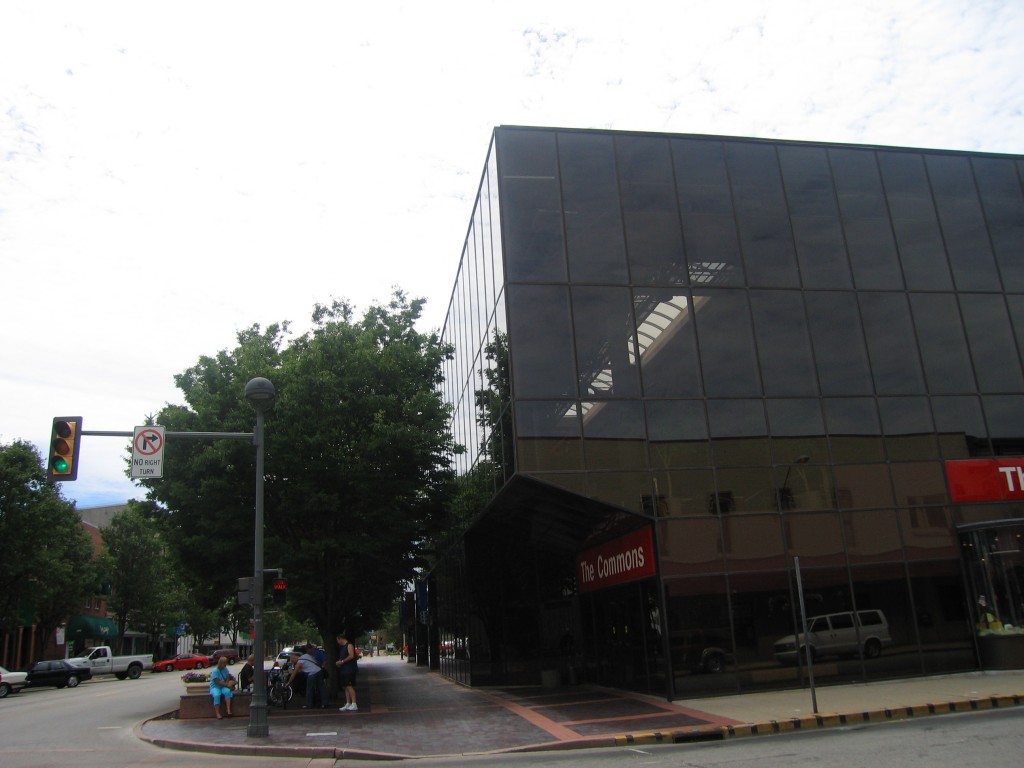 Looking down Washington street along the front of the Commons (photo by Ricky Berkey)
Looking down Washington street along the front of the Commons (photo by Ricky Berkey)
 Building set back at corner to complement the Courthouse (photo by Ricky Berkey)
Building set back at corner to complement the Courthouse (photo by Ricky Berkey)
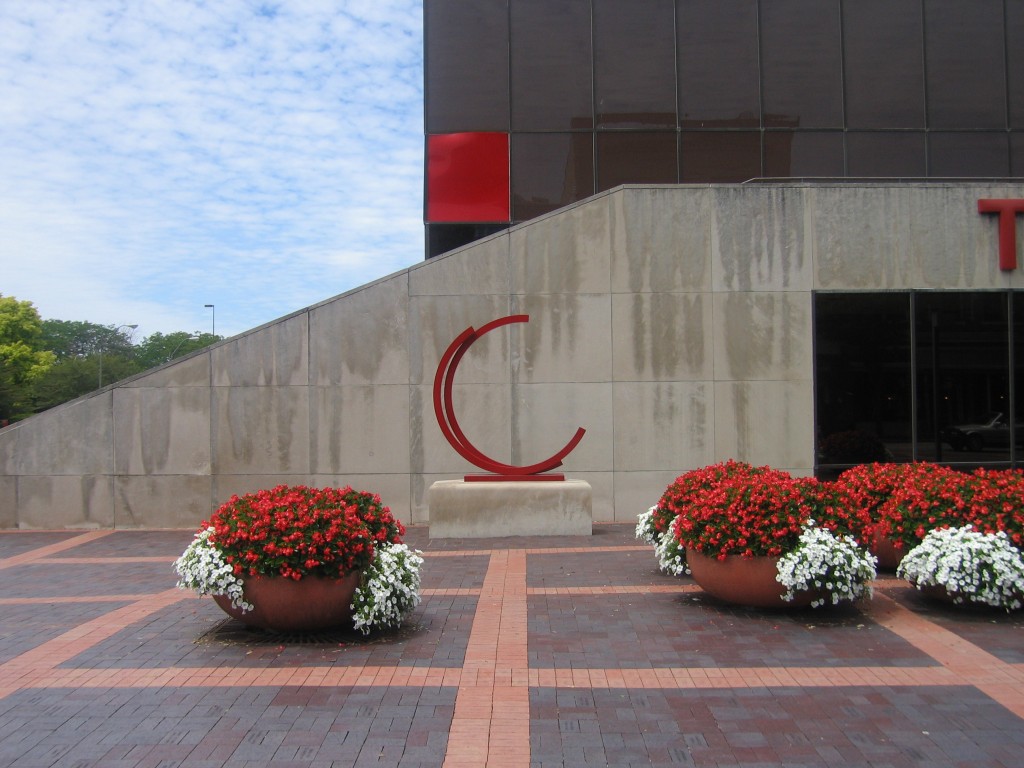 Front courtyard area enhanced by a Bernar Venet sculpture (photo by Ricky Berkey)
Front courtyard area enhanced by a Bernar Venet sculpture (photo by Ricky Berkey)
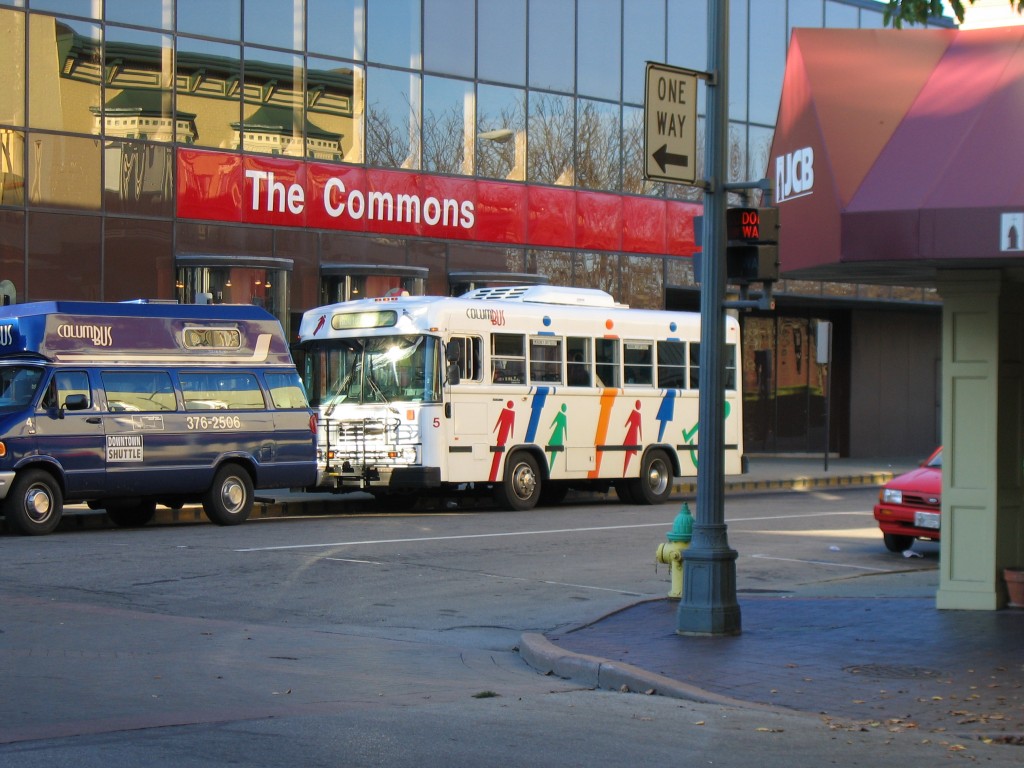 Side view showing city bus transfer point; the Commons may have been the nicest bus shelter ever! (photo by Ricky Berkey)
Side view showing city bus transfer point; the Commons may have been the nicest bus shelter ever! (photo by Ricky Berkey)
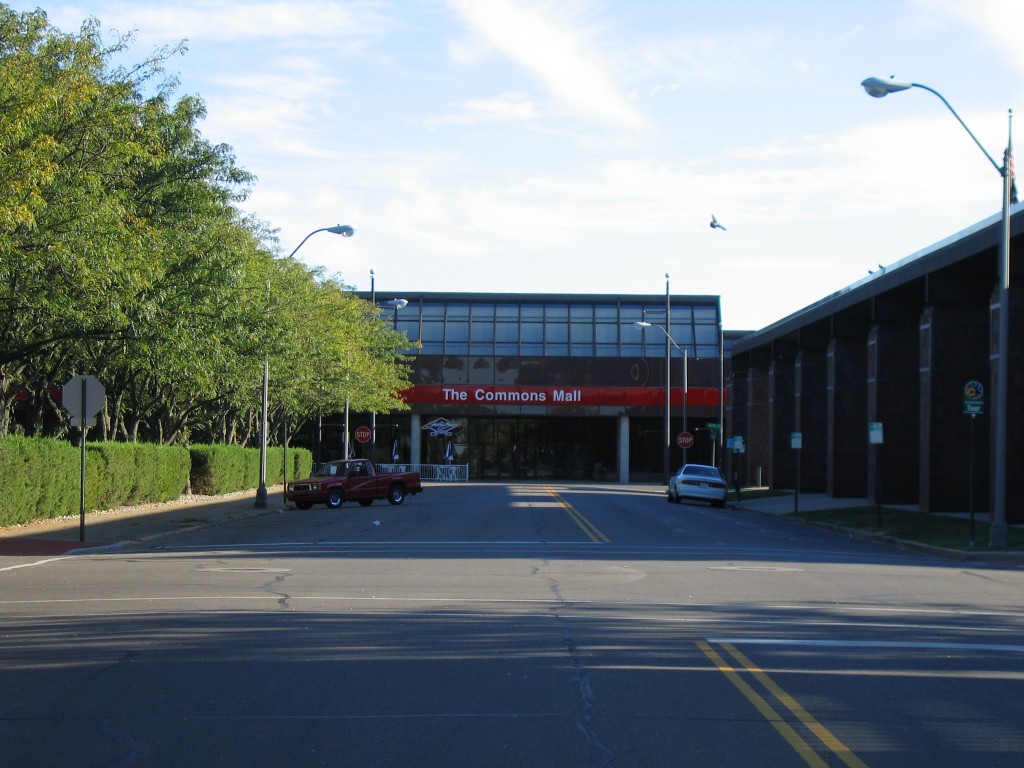 Side entrance to the Commons Mall from Jackson Street. This portion of the Mall is now demolished and the street has been reopened, the lovely tree-lined parking lot to the left is now a parking garage (photo by Ricky Berkey)
Side entrance to the Commons Mall from Jackson Street. This portion of the Mall is now demolished and the street has been reopened, the lovely tree-lined parking lot to the left is now a parking garage (photo by Ricky Berkey)
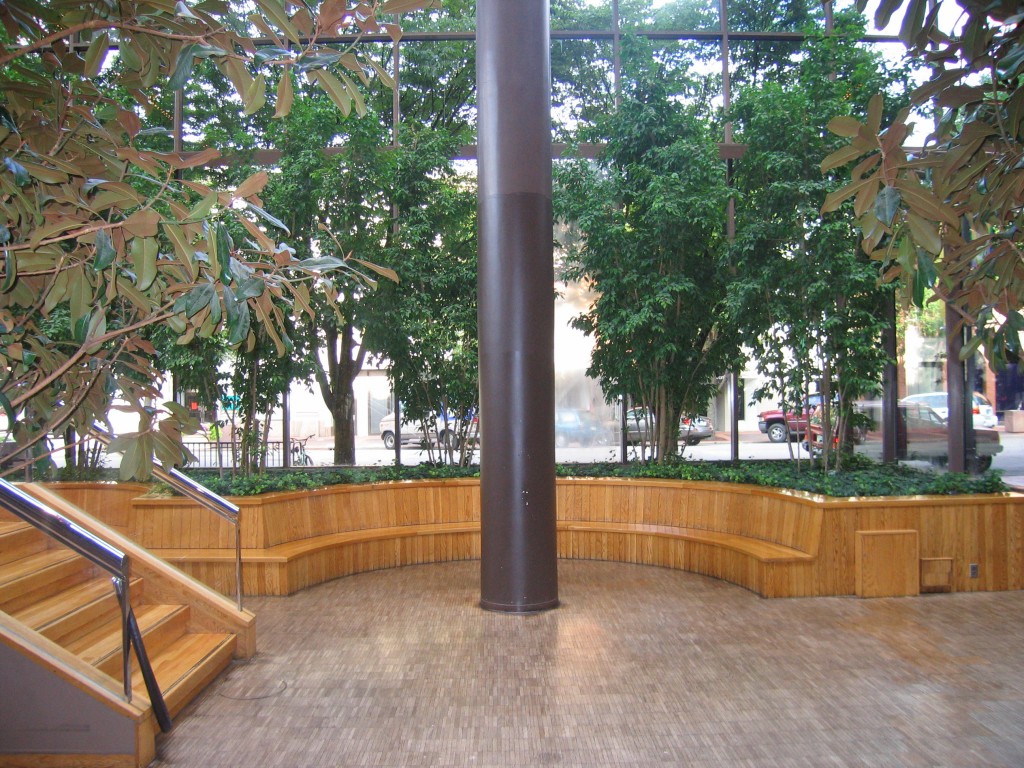 Inside the Commons showing seating areas and trees (photo by Ricky Berkey)
Inside the Commons showing seating areas and trees (photo by Ricky Berkey)
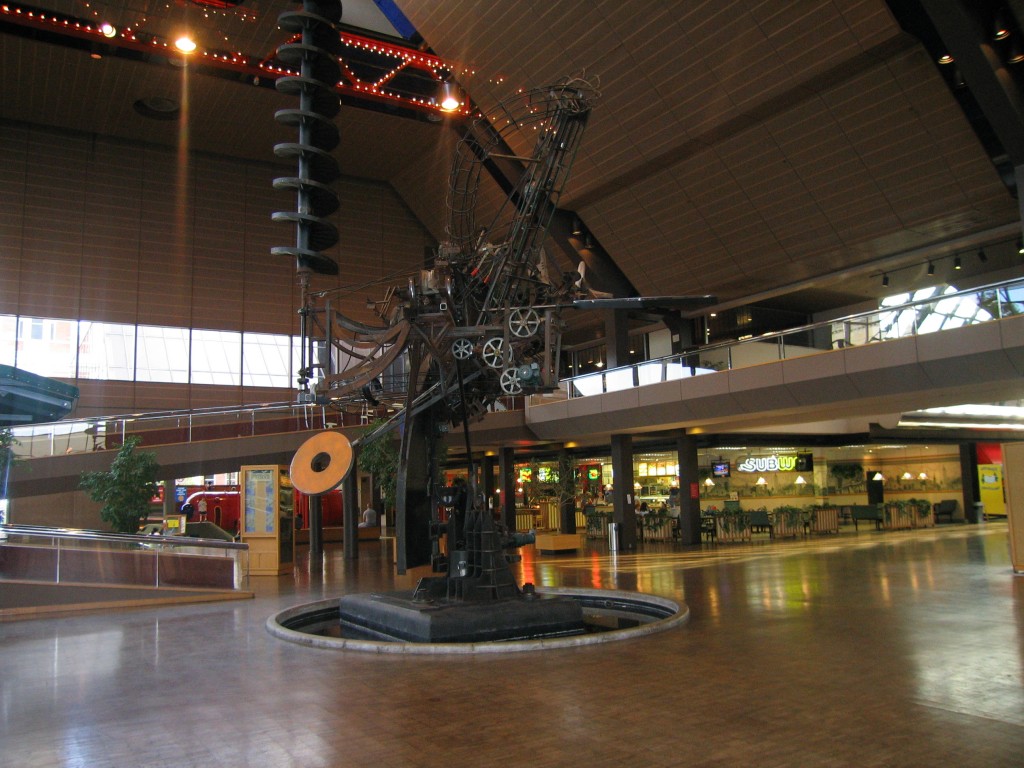 Chaos 1 sculpture by Jean Tinguely (photo by Ricky Berkey)
Chaos 1 sculpture by Jean Tinguely (photo by Ricky Berkey)
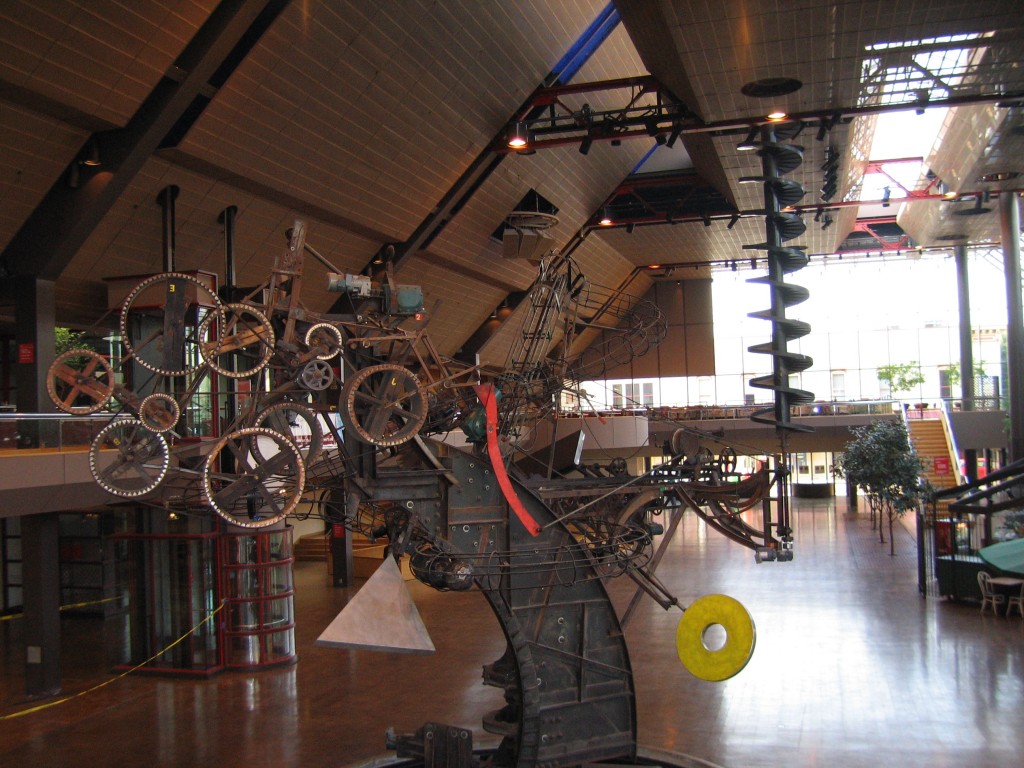 Chaos 1 sculpture by Jean Tinguely (photo by Ricky Berkey)
Chaos 1 sculpture by Jean Tinguely (photo by Ricky Berkey)
 Showing the Mall concourse from the Commons; note the mirror to the left giving the skylight a gabled effect (photo by Ricky Berkey)
Showing the Mall concourse from the Commons; note the mirror to the left giving the skylight a gabled effect (photo by Ricky Berkey)
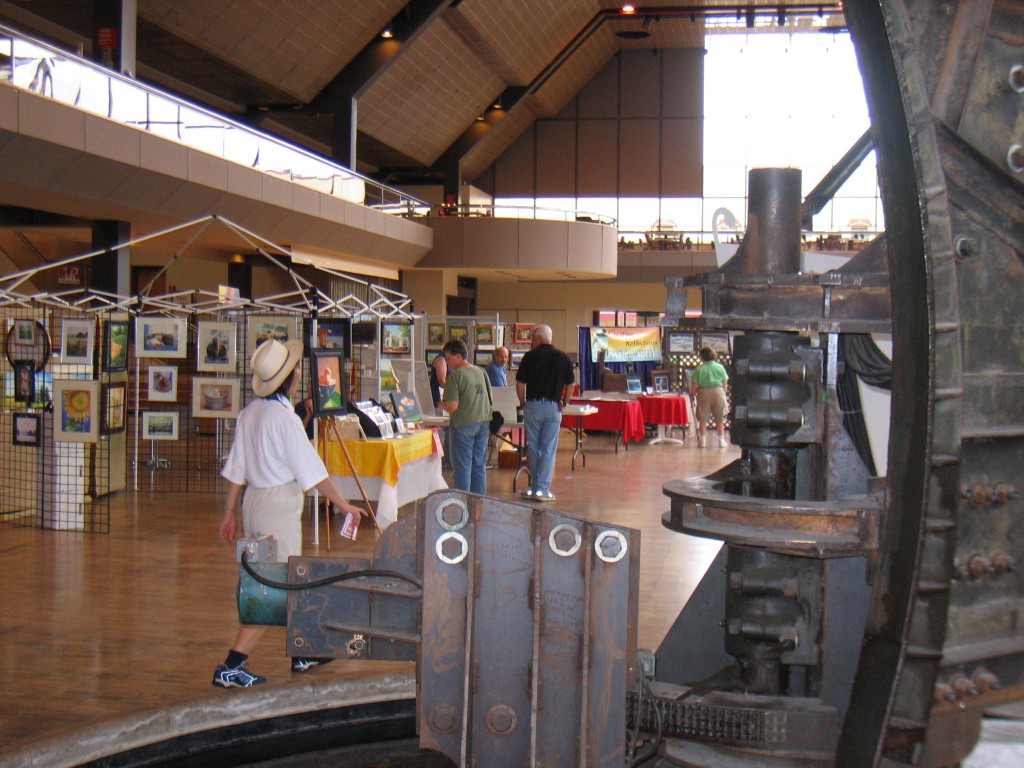 One of many events held in the Commons public space (photo by Ricky Berkey)
One of many events held in the Commons public space (photo by Ricky Berkey)
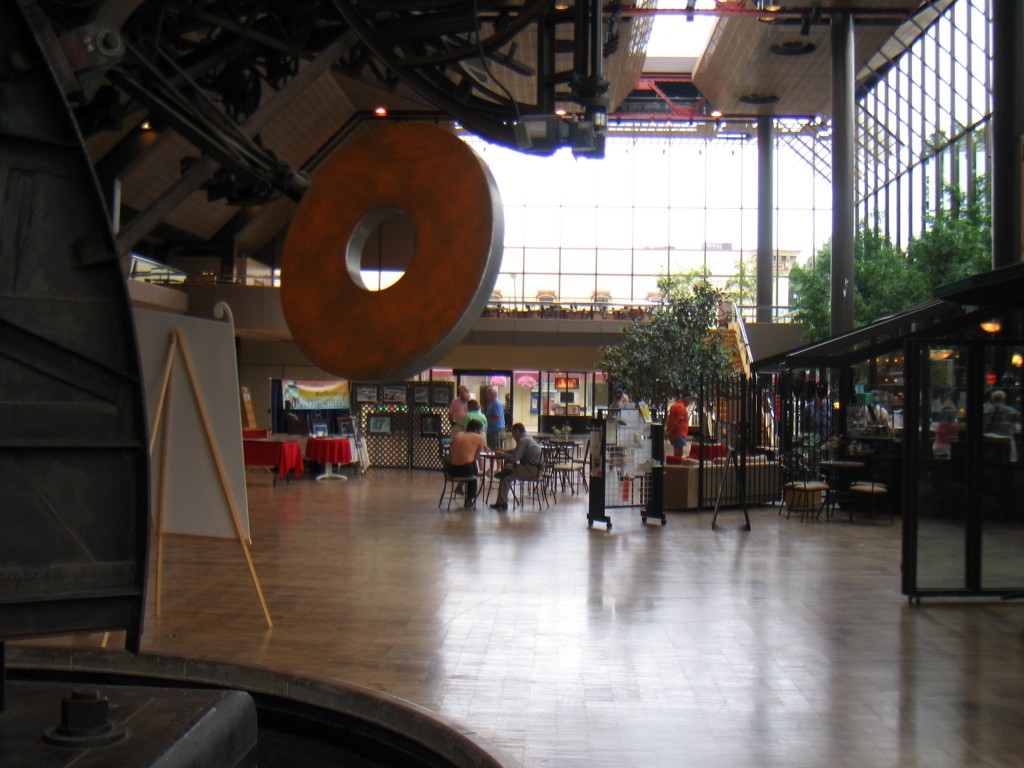 One of many events held in the Commons public space (photo by Ricky Berkey)
One of many events held in the Commons public space (photo by Ricky Berkey)
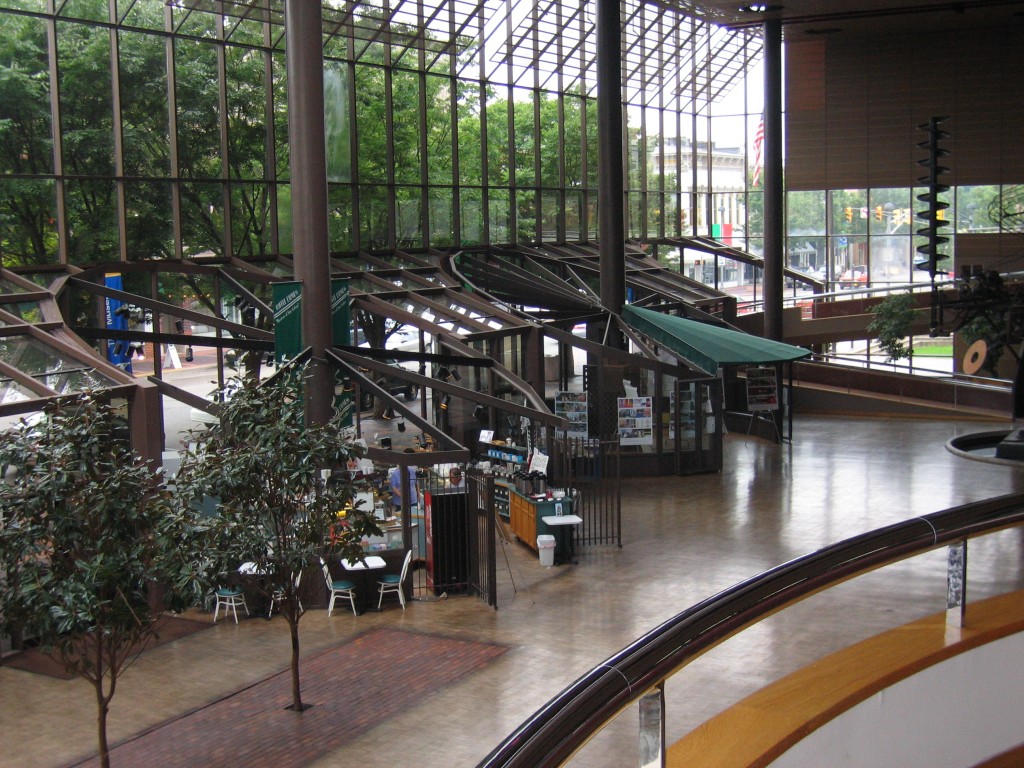 View of lower kiosks from the Commons mezzanine level (photo by Ricky Berkey)
View of lower kiosks from the Commons mezzanine level (photo by Ricky Berkey)
 Seating area on Commons mezzanine level (photo by Ricky Berkey)
Seating area on Commons mezzanine level (photo by Ricky Berkey)
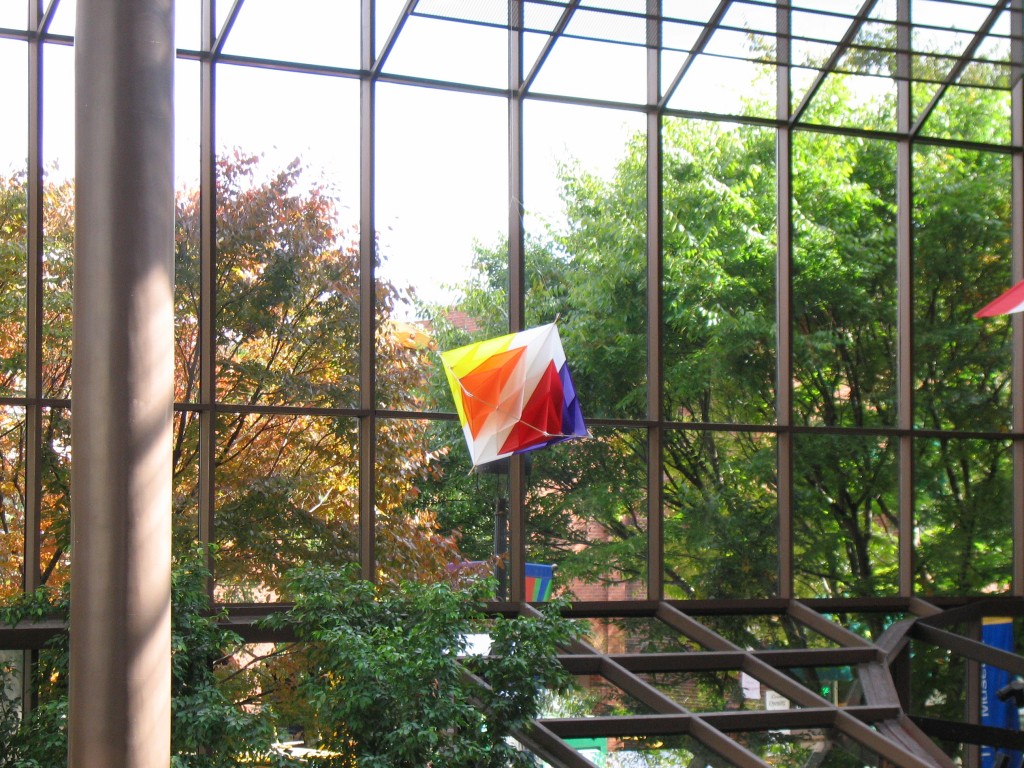 Views to the outside from the Commons public space (photo by Ricky Berkey)
Views to the outside from the Commons public space (photo by Ricky Berkey)
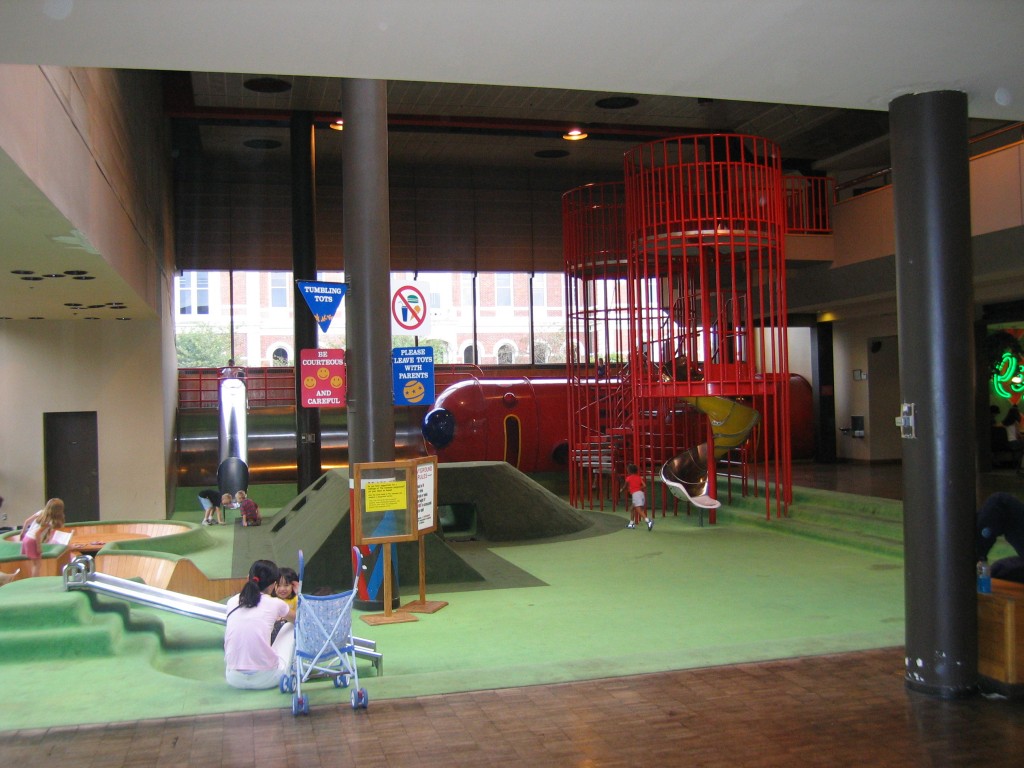 Our beloved indoor children’s playground (photo by Ricky Berkey)
Our beloved indoor children’s playground (photo by Ricky Berkey)
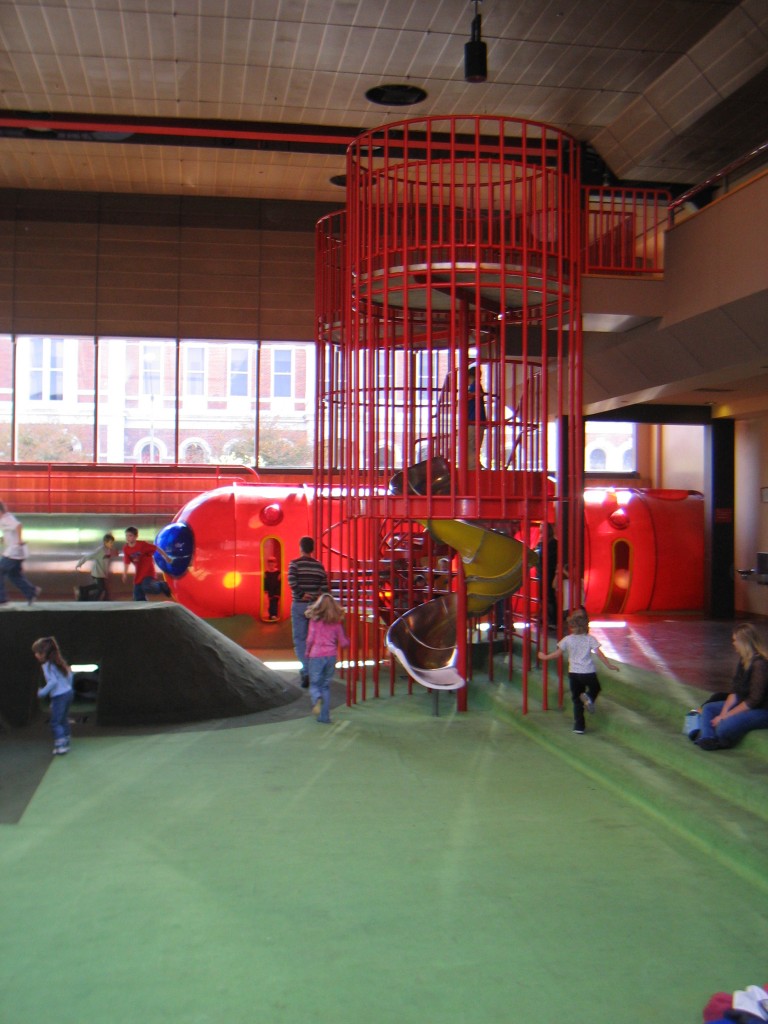 There used to be a two-story circular stairway and fireman pole in the red cylinders; later replaced by a slide only halfway up for safety considerations (photo by Ricky Berkey)
There used to be a two-story circular stairway and fireman pole in the red cylinders; later replaced by a slide only halfway up for safety considerations (photo by Ricky Berkey)
 Broke my heart to watch the Commons being demolished! (photo by Ricky Berkey)
Broke my heart to watch the Commons being demolished! (photo by Ricky Berkey)
The Architects
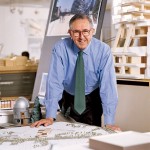 Cesar Pelli
Cesar Pelli
- Born in Tucuman, Argentina on October 12th, 1926
- University of Tucuman – Argentina
- University of Illinois
- AIA (American Institute of Architects) Gold Medal Award (1995)
Cesar Pelli has been praised for using a wide variety of materials and designs, seeking new solutions for each location rather than duplicating a certain trademark look. Believing that buildings should be “responsible citizens”, Cesar Pelli strives to design buildings that work within the surrounding city. Pelli has said: “It is a great honor for an architect to be given a piece of a city in which to design, however small it may be…The city is more important than the building and the building is more important than the architect”.
Born in Argentina in 1926, he emigrated to the United States and chose to become a citizen in 1964. He was an associate architect with Eero Saarinen from 1952-1964 (another “Cranbrook Connection in Columbus). While with Saarinen, he served as project designer for the TWA Terminal Building at JFK Airport in NYC. In 1968 he became a design partner with Gruen & Associates where he remained until 1977 when he started his own firm, Cesar Pelli & Associates (now Pelli-Clarke-Pelli). His son Rafael is now a partner in the firm. Cesar Pelli has cited Eero Saarinen and Le Corbusier as among his greatest career influences.
Cesar Pelli taught for many years and served as Dean of the Yale University School of Architecture from 1977 to 1984. He has received over a hundred awards for architecture including the AIA (American Institute of Architects) Gold Medal in 1995 which recognizes a lifetime of distinguished achievement. In 1991, the AIA listed Pelli among the ten most influential living American architects. He has designed buildings large and small around the world including some of the world’s tallest skyscrapers.
Selected Cesar Pelli Projects
1966: Worldway Postal Center – Los Angeles, California
1967: COMSAT Laboratories – Clarksburg, Maryland
1967: Kukui Gardens Housing – Honolulu, Hawaii
1969: San Bernardino City Hall – San Bernardino, California
1972: US Embassy – Tokyo, Japan
1973: The Commons and Courthouse Mall – Columbus, Indiana
1975: Pacific Design Center – Los Angeles, California
1984: Herring Hall (Rice University) – Houston, Texas
1984: MOMA Residential Tower – NYC
1984: Mattatuck Museum – Waterbury, Connecticut
1986: Canary Wharf Tower – London, England
1987: World Financial Center and Winter Garden – NYC
1987: Charlotte Performing Arts Center – Charlotte, North Carolina
1990: Carnegie Hall Tower – NYC
1990: NTT Headquarters – Tokyo, Japan
1991: Ohio Center for Performing Arts – Cincinnati, Ohio
1995: Aronoff Center for Performing Arts – Cincinnati, Ohio
1996: Cinema – Celebration, Florida
1998: Petronas Towers – Kuala Lumpur, Malaysia
2000: Kurayoshi Park Square – Kurayoshi, Japan
2000: KABC-TV – Los Angeles, California
2002: JP MorganChase Building – San Francisco
2002: Weber Music Hall at University of Minnesota – Duluth, Minnesota
2002: Enron Headquarters – Houston, Texas
2003: Two International Finance Centre – Hong Kong
2003: Benjamin & Mariam Schuster Performing Arts Center – Dayton, Ohio
2004: Goldman Sachs Tower – Jersey City, New Jersey
2005: Cira Centre – Philadelphia, Pennsylvania
2005: Malone Engineering Center at Yale University – New Haven, Connecticut
2006: Adrienne Arsht Center for the Performing Arts – Miami, Florida
2006: Minneapolis Central Library – Minneapolis, Minnesota
2008: BOK Center – Tulsa, Oklahoma
2008: One Park West – Liverpool, England
2009: Connecticut Science Center – Hartford, Connecticut
2011: Advanced Manufacturing Center of Excellence (AMCE) – Columbus, Indiana
 Jean Tinguely
Jean Tinguely
- Born in Fribourg, Switzerland on May 22nd, 1925
- Died in Berne, Switzerland on August 30th, 1991
- Basel School of Fine Arts (1945)
Jean Tinguely was a Swiss sculptor and artist best known for his machine-like kinetic sculptures, many of which were intended to destroy themselves as part of their operation. He studied painting and sculpture, early on developing an interest in movement as an artistic medium. He moved to Paris in 1953 and began to construct his first large scale kinetic sculptures which he called “métaméchaniques” or “metamechanicals”, robot-like contraptions whose individual parts often moved or spun at varying speeds. Another type of project was his series called “machines à peindre” (“painting machines”) which continuously painted abstract patterns to the accompaniment of self-produced sounds and noxious odors! He created the first of his self-destroying structures in the early 60’s. His “Homage to New York” was a 27 foot sculpture intended to destroy itself but it had to be helped along by NYC fireman after it started a fire. He saw the concept of destruction as a means of achieving his goal of “dematerializing” art. In the ’70s he went on to create less aggressive and more whimsical kinetic constructions that combined aspects of the machine with those of found objects, or junk such as “Chaos 1” which was the centerpiece of Cesar Pelli’s Commons building in Columbus, Indiana. He saw his work as a satire on the mindless overproduction of material goods. He also celebrated the machine and the beauty of objects discarded by our consumerist society. He continued producing major projects and exhibitions well into the 80’s. He died in 1991.
Selected Jean Tinguely Projects
1960: “Homage to New York” (a 27 foot high machine intended to destroy itself at the Museum of Modern Art in NYC)
1961: “Hon” (a climbable female sculpture created with his wife, Niki de Saint Phalle)
1962: “Study for an End of the World No. 2” (a creation detonated in front of an audience gathered in the desert outside Las Vegas, Nevada)
1963: “Heureka” (a large sculpture created for the Expo 64 in Lausanne).
1974: “Chaos 1” (kinetic junk sculpture created for the Commons in Columbus, Indiana)
1981: “La Fountaine” (a fountain sculpture in Paris, France)
Historic Columbus
This is one of the buildings along Washington Street in the block that was soon torn down to make way for the Commons in the early 70’s.
Links/References
Pelli-Clarke-Pelli: Cesar Pelli’s official website
The Commons: The original Commons and Mall project (still featured on Pelli’s website!)
City of Columbus: official City of Columbus website
Columbus Indiana Architectural Archives
Columbus Indiana Architecture Digital Archives: A small portion of the Columbus Indiana Architectural Archives available online from the IUPUI digital library
3D Models of Columbus Architecture Executed in Google SketchUp:
The Republic Newspaper – Columbus, Indiana newspaper
Bartholomew County Public Library
Historic Columbus Website – David Sechrest’s tribute to Columbus History
Historic Columbus Message Board – a companion interactive forum to the David Sechrest historical website
Bartholomew County Historical Society
 Click HERE for a Calendar of Upcoming Events in the Columbus Area.
Click HERE for a Calendar of Upcoming Events in the Columbus Area.
Click HERE for information about Tours of Columbus Architecture and Design including the Miller House.
 Ricky Berkey
Ricky Berkey
Email me: rickyberkey@gmail.com

